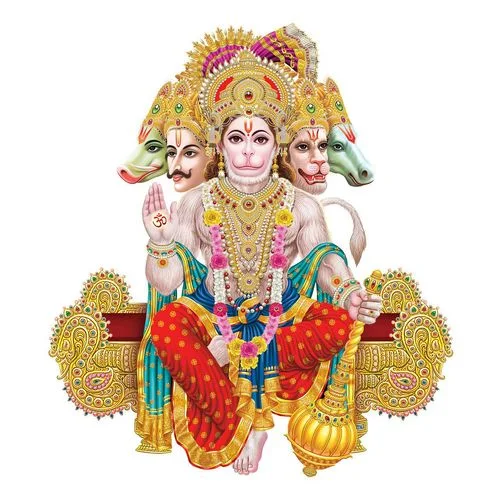The Amazing Powers of Panchmukhi Hanuman
Panchmukhi Hanuman Ji
Maharaj:
Panchmukhi is a
Sanskrit word meaning 'Five faced'. Shree Hanuman manifested himself in
Panchamukha or Panchmukhi avatar to kill Ahiravana. The origin of Shree
Panchmukhi Hanuman can be traced to a story in the Adbhuta Ramayana but does
not exist in the original Valmiki Ramayana. This story will go to be very
interesting and informative.
 |
| Panchmukhi Hanuman |
Why did Hanuman Ji take the Panchmukh avatar?
Ahiravana, a
powerful Demon, was the brother of Ravana. During the Ramayana battle, when Laxmana
killed Indrajit the son of the Lanka Naresh Ravana, Ravana approached his
brother Ahiravana for help. He was the king of the underworld or Pataal Lok.
When Vibhishana came to know about this, he rushed to warn Rama and Laxmana.
Vibhishana asked Hanuman to stay alert and not let anyone enter the premises
where Lord Rama and Laxmana reside.
Ahiravana
tried so hard to enter the premises but couldn't succeed; Lord Hanuman foiled
his every attempt. At last, Ahiravana decided to disguise himself in the form
of Vibhishana. Hanuman couldn't recognize him, and he let him enter the room
where Rama and Laxmana were staying. Once Ahiravana entered the room, he
abducted Rama and Laxmana and took them to the underworld. When Hanuman came to
know about the incident, he approached Vibhishana and informed him. Vibhishana
asked Hanuman to rescue him quickly or else Ahiravan would sacrifice him.
Read this also: Hanuman Chalisa lyrics with meaning
Hence,
Hanuman went on a rescue mission to save both Rama and Laxmana. When Lord
Hanuman reached the door of Pataal Lok, he was stopped by a strange creature.
The creature had half the body of a Vanara or money and half the reptile; he
was the guard of the door.
Hanuman
asked for his introduction to which he said that he was Makardhwaja, the son of
Hanuman. This surprised Hanuman as he had been a (Bramhachari) skilled celibate
throughout his life. Makardhwaja explained that when Hanuman took a dip in the
Indian ocean after burning down the whole of Lanka with his inflamed tail, a
drop of his sweat fell into the mouth of a crocodile which is called 'Makara'
in the Sanskrit language. The crocodile later gives birth to his son
Makardhwaja, who went to become the gatekeeper of Patal Lok under Ravana's
cousin Ahiravana.
After a
brief fight, Hanuman defeated Makardhwaja and entered the Patal Lok. Ahiravana
was backed by a strong army, Chandrasena informed him about the secret of
killing Ahiravana and that his life force is in five different Diya (candles)
which had been kept in five different directions. The only way to kill
Ahiravana was to blow off all these five candles at the same time.
Read this also: Vishnu Sahasranamam lyrics with meaning
Hanuman
appeared in a five-faced form and extinguished the five candles and killed
Ahiravana. He then rescued Lord Rama and Laxmana who were in the unconscious
stage by a magic spell. In the Panchamukha Avatar, each face of Lord Hanuman
represents a God and has its significance.
What does the Panchmukhi Hanuman avatar represent
to us? | The hidden secrets of the Panchmukhi Hanuman temple
- The face towards the East is 'Shree Anjaneya' which removes all blemishes of sin and confers purity of mind.
- The south-facing Mukha is "Shree Narasimha" which removes the fear of enemies and confers victory.
- The west-facing Mukha is of "Shree Mahaveera Garuda" that drives away evil spells, and black magic influence and removes all poisonous effects in one's body.
- The north-facing Mukha is of "Shree Lakshmi Varaha Murthy" that wards off the troubles caused by bad influences of the planets and confers all prosperity of Ashta Aishwariya.
- The face looking upwards is of "Shree Haygreeva" which confers knowledge, victory, progeny, and Mukti or freedom.
Conclusion:
Panchamukha
can be interpreted as the five ways of praying to god in Hindu philosophy.
These five ways are known as Naman, Smaran, Keerthanam, Yacham, and Arpanam,
also a depiction of one of these five forms of worship. If you like this
article then never forget to share it with friends and family, and of course,
do Subscribe Million-$-Knowledge to get daily updates like this.
Read More:
- Shiva - The Most Powerful God in the Universe
- Swami Vivekananda and Ramakrishna First Meeting
- The secret of work summary by Swami Vivekananda
- Trishul: The Hindu Mythological Weapon of Destruction
Thank You!
Million-$-Knowledge





